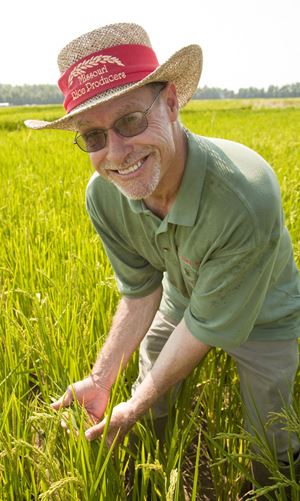Breeder Explains Program Offerings
BETTY VALLE GEGG-NAEGER
MidAmerica Farmer Grower
MALDEN, MO.
Rice varieties that have come through the Missouri Rice Breeding Program were introduced recently by Dr. Donn Beighley, rice breeder with Southeast Missouri State University located at Missouri Rice Research Farm at Glennonville Mo.
He discussed the different varieties that are being tested in the state of Missouri, both released varieties as well as four new experimental varieties from the breeding program. He gave producers an update on those lines.
“We realize that we don’t develop a variety and then just hand it off; we have to find out a little bit more about the production of that variety, such as what is the best nitrogen rate application for each one because we want to maximize our yields,” he explained.

“Another factor that we talk about is the purification of varieties. This is basically a four-year program, beginning with harvesting individual panicles, from which we grow a row of rice, we harvest that row and grow a plot. After the plots, we will actually grow strips of those varieties to see how they perform grown on a larger area. At each stage we are looking for off-type plants – either early, late or tall varieties. Any one of those factors can lead to the dropping of that particular row.”
Beighley talked about some other things going on now. He’s looking at about 3,600 plots this year which results in about 1,200 varieties in replicated plots at the Rice Research Farm.
“The best variety that I’m looking at is our medium grain,” Beighley said. “We know it as Missouri 5035, it’s also known as RU1305001 because we actually are testing it in Arkansas, Louisiana, Texas and Mississippi, This particular variety has yielded very well in our trials over the last three years and we had enough seed this year to share with some of these other states. We also have three other varieties that are doing very well, one of which is a medium grain and then two long grains. We’re really looking forward to see how those lines perform in those different testing locations before we make a final decision on their release.”
Beighley concluded his remarks with advice to producers:
“The take home message this particular year is don’t be in too big a rush to get your crop out because what we’re basically seeing in the DD50 program is anywhere from a seven- to nine-day later maturity than we saw when we ran the DD50 earlier in the growing season. So we can expect a later crop.”∆
BETTY VALLE GEGG-NAEGER: Senior Staff Writer, MidAmerica Farmer Grower